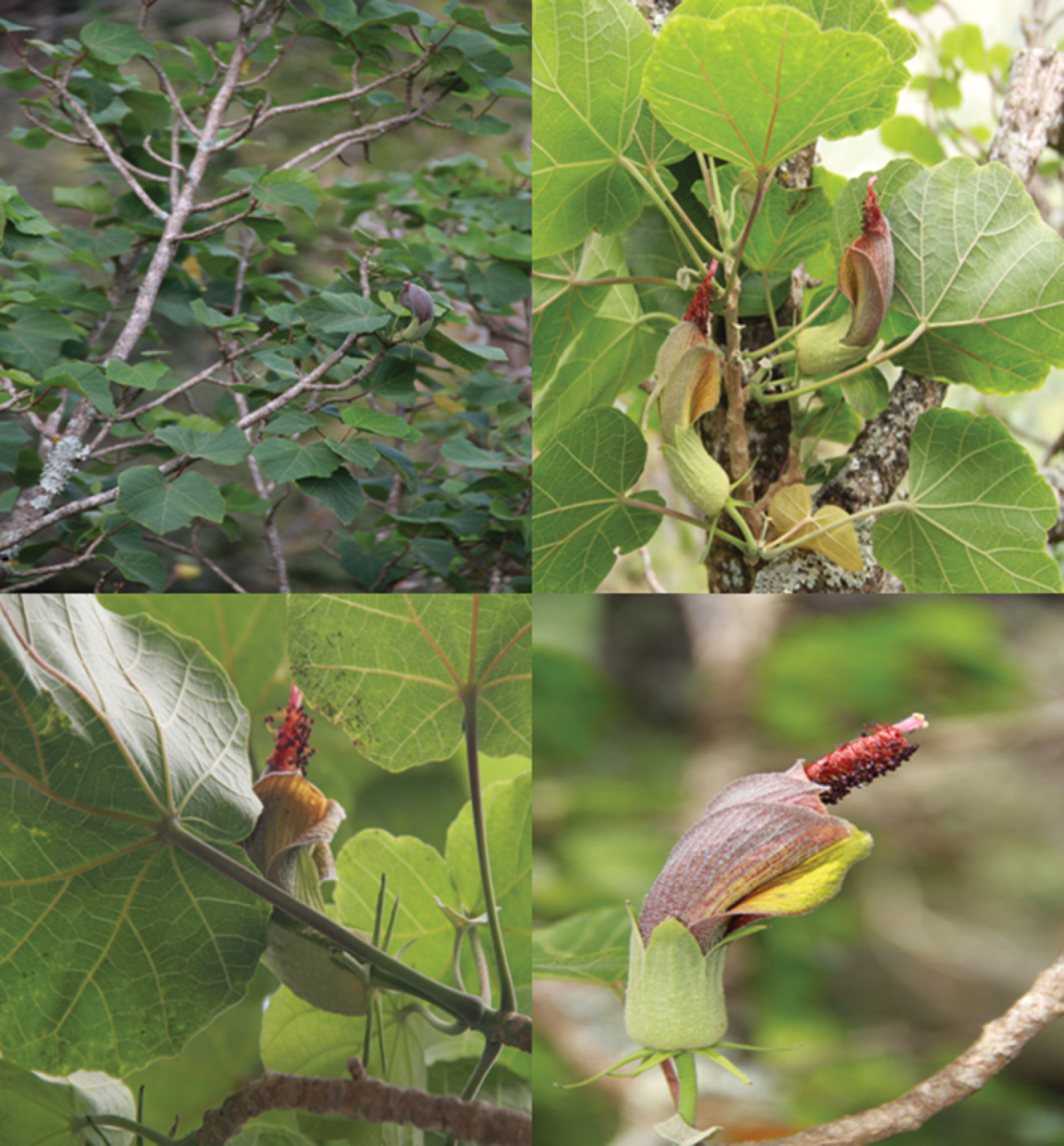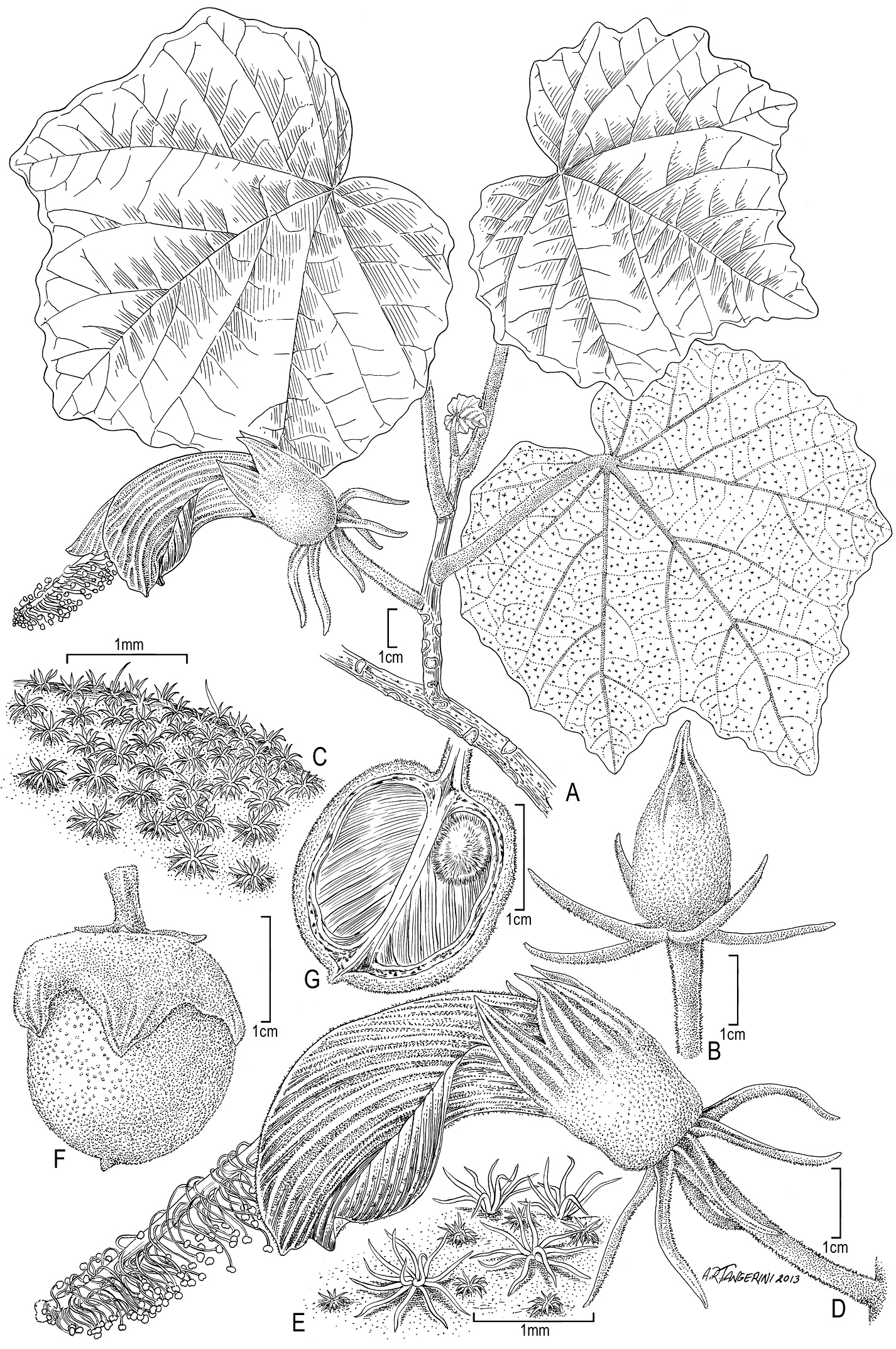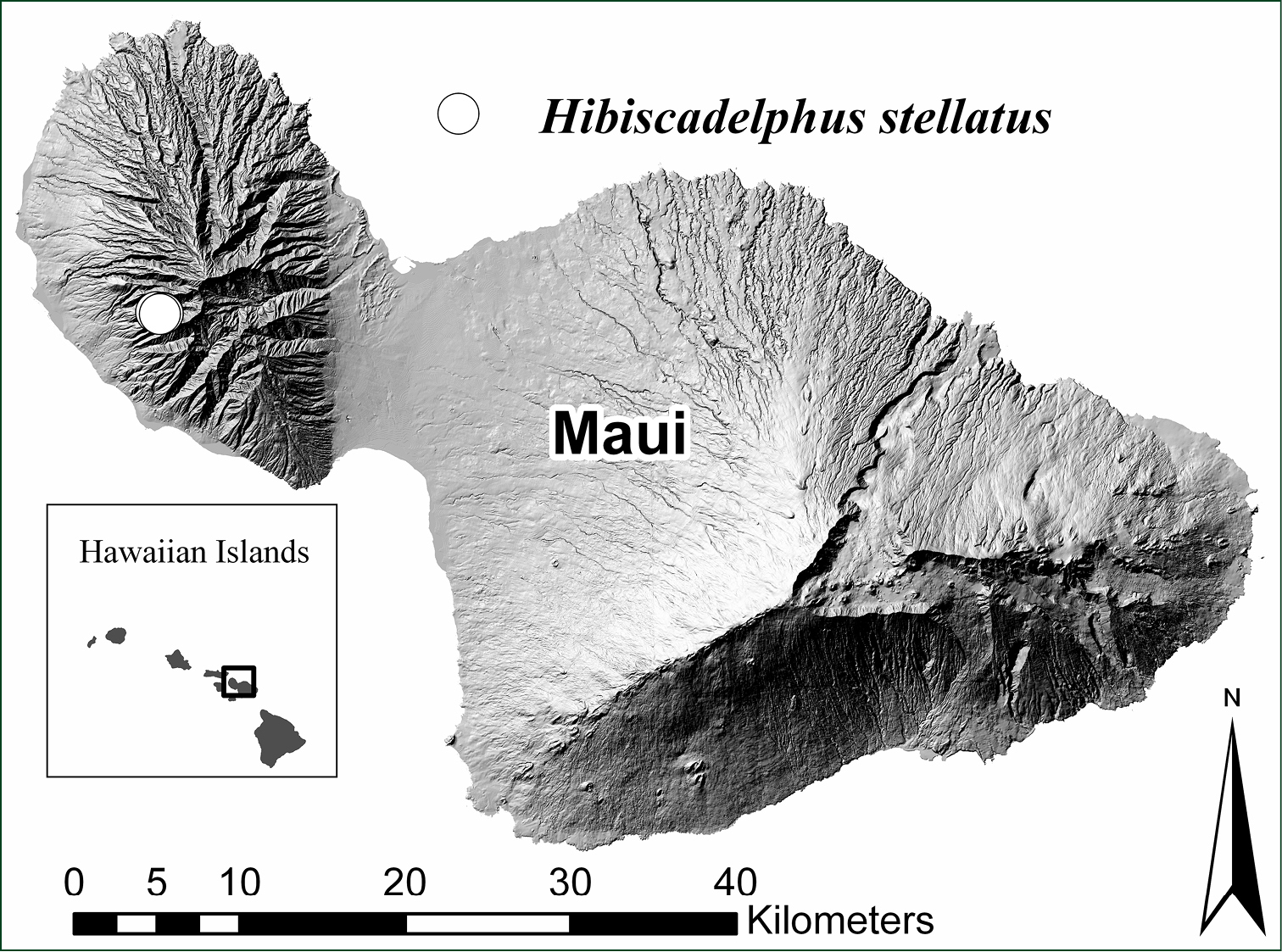






Citation: Oppenheimer HL, Bustamente KM, Perlman SP (2014) A new species of Hibiscadelphus Rock (Malvaceae, Hibisceae) from Maui, Hawaiian Islands. PhytoKeys 39: 65–75. doi: 10.3897/phytokeys.39.7371
Hibiscadelphus stellatus H. Oppenheimer, Bustamente, & Perlman, sp. nov., a new, narrowly endemic species from West Maui, Hawaiian Islands is described, illustrated and its affinities and conservation status are discussed. It is currently known from three populations totaling 99 plants in Kaua`ula valley on leeward western Maui. It differs from H. wilderianus, its nearest congener, in its denser white or tan stellate pubescence on most parts; larger externally purple colored corollas that are 5–6.5 cm long; linear-subulate to lanceolate, acute to acuminate involucral bracts; globose-cuboid to ovoid capsules; and endocarp with scattered hairs.
Malvaceae, Hibiscadelphus, Hawaiian Islands, Maui, conservation, IUCN Red List
Joseph Rock described the endemic Hawaiian genus Hibiscadelphus Rock in 1911 based on Hibiscadelphus giffardianus Rock (
In addition to establishing the genus, Rock described three species: Hibiscadelphus giffardianus Rock from Mauna Kea, Hibiscadelphus hualalaiensis Rock from Hualalai, both on Hawai`i Island, and Hibiscadelphus wilderianus Rock from Auwahi on the island of Maui (
Current status of Hibiscadelphus.
| Extinct | Cultivation only | Extant in wild | USFWS status | IUCN status | |
|---|---|---|---|---|---|
| Hibiscadelphus bombycinus | × | Species of Concern | EX | ||
| Hibiscadelphus crucibracteatus | × | Species of Concern | EX | ||
| Hibiscadelphus distans | × | Endangered | CR | ||
| Hibiscadelphus giffardianus | × | Endangered | CR | ||
| Hibiscadelphus hualalaiensis | × | Endangered | CR | ||
| Hibiscadelphus stellatus | × | EN | |||
| Hibiscadelphus wilderianus | × | Species of Concern | EX | ||
| Hibiscadelphus woodii | × | Endangered | CR |
During the course of field work on west Maui in 2012 the authors discovered two populations (25 and 51 plants) over 400 m apart of a previously unknown Hibiscadelphus species on the steep slopes of Kaua`ula Valley on leeward, western Maui. A year later a third colony was found between the first two locations with 23 plants. Hibiscadelphus had not been observed, reported or documented previously on west Maui. Study of the collected specimens and comparison with collections of other known species at the BISH and PTBG herbaria, and images on JSTOR Global Plants revealed they represent an undescribed species.
urn:lsid:ipni.org:names:77140885-1
Differs from Hibiscadelphus wilderianus in its denser pubescence especially on leaves, petioles, peduncles, involucral bracts, and corolla; linear-subulate to lanceolate involucral bracts, with acute to acuminate apices; evenly 5-lobed calyx; wider, densely pubescent, externally purple, internally yellow corolla lobes; and ovate to sub-globose capsules, 2.5–3.5 × 2.2–3.2 cm with scattered long hairs on the endocarp.
USA. HAWAIIAN ISLANDS: West Maui, Lahaina District, Kaua`ula Valley, south slope, 841 m, 13 Feb 2014, Oppenheimer, Bustamente & Perlman H21404 (holotype: BISH; isotypes: MO, NY, PTBG, US).
Small trees 3–6 m tall, many branched, trunks to 30 cm dbh, bark smooth, light tan to gray, young branchlets densely white to tan pubescent with 8–12-rayed stellate trichomes 0.3–0.4 mm in diam., surface scurfy-waxy, glabrescent with age; petiole scars prominent, subcircular, 2.5–4 mm in diam. Leaves chartaceous, new growth densely stellate-pubescent, mature leaves with blades broadly-ovate to suborbicular or subreniform in outline, occasionally shallowly 3-lobed, 7.5–16(–18) cm long, (8)9.5–13.5(–18) cm wide, veins prominulous, primary veins 7–9 radiate from base, midvein with 3–4 pairs of secondary veins arising along midrib, light green to occasionally red tinged when fresh, higher order venation prominulous on both surfaces, margins irregularly broadly crenate, base cordate, with a wide to narrow but usually open sinus, apex acute to obtuse or rounded, green when fresh with scattered tan stellate pubescence on both surfaces, densely so along veins and adaxial surface, trichomes 0.2–0.4 mm in diam. with (2–)8–16 rays, abaxial surface with principal vein axils domatiate with dense tufts of tan to white trichomes 0.2–0.3 mm long; petioles 3.5–6cm long, green or sometimes red-tinged, pubescent with dense white to tan stellate trichomes as on branchlets; stipules lanceolate to subulate, 2–3.5 mm long, apex acute, green, sparsely to densely tan or white stellate pubescent, soon caducous. Flowers solitary, axillary, erect to spreading, pedicels 22–30 mm long, green or sometimes red-tinged, densely white to tan stellate pubescent as in petioles, involucral bracts 5–6 (–7), linear-subulate to lanceolate (rarely spathulate), acute to acuminate apically, connate only at base, 9–22 mm long, 1–2 mm wide at base, erect, appressed or spreading perpendicular to the floral axis in anthesis, green, densely tan or white stellate pubescent with trichomes 0.2–0.3 mm in diam. Calyx tubular-saccate, mostly 5-lobed, tube 22–30 mm long, 19–20 mm wide, the lobes triangular, acute to short acuminate 5–10 mm long, 7–8 mm wide, green, surface obscured by dense tan stellate pubescence as in bracts, in mature fruit splitting along one side but persistent. Corolla zygomorphic, adaxially curved, 5–6.5 cm long, lobed nearly to base, lobes coalescent, 6–6.5 cm long, 3.5–4 cm wide, obovate-spathulate, apex obtuse, tips and outer margins slightly reflexing with age, outer exposed portion purple, purple-green or purple-yellow, inner concealed portion yellow, conspicuously veined, densely covered with gray or tan stellate trichomes especially along veins, internally yellow or purple-tinged distally, purple toward base, corolla usually becoming purplish with age, staminal column and apex of the style exserted for 1.5–2.5 cm; staminal column 8–8.5 cm long, antheriferous in distal 3.5 cm, maroon-purple, antheriferous in distal 3.5 cm, stamens c. 100, anthers reniform-curved, 0.8–1.5 mm long, purple, filaments 6–12 mm long, purple, pollen grains purple turning golden yellow after anther dehiscence; style 8.5–9 cm long, style branches 3–5 mm long, villose, stigmas rounded, c. 1 mm long, yellow, ovary dome-shaped, 8 mm long and wide. Fruit a woody capsule, globose-cuboid to -ovoid, 5-locular, 5-valved, 2.5–3.5 (–4) cm long, 2.2–3.3 cm in diameter, surface yellowish brown, rough densely covered with dense tan stellate hair clusters, appearing tuberculate, mericarps 10, mesocarp well developed, reticulate, endocarp chartaceous, loose, with scattered long hairs, testa brown. Seeds 1–2 per mericarp, reniform, 8–10 mm long, 6–8 mm wide including the dense, lanate yellowish-tan hairs 0.4–1 mm long.
Hibiscadelphus stellatus. A Habit B Flowers and leaves (from the holotype) C View of bracts illustrating stellate arrangement D Close-up of flower. (from the holotype). All photos by the authors.
Hibiscadelphus stellatus H. Oppenh., Bustamente, & Perlman. A Habit B Flower bud C Surface of calyx showing stellate hairs D Flower E Surface of corolla showing two sizes of stellate hairs F Fruit G Longitudinal section of fruit showing seed. Drawn from Oppenheimer et al. H41337 (US) and field photographs by the authors.
Known only from west Maui, Hawaiian Islands at 20.87°N, 156.62°W (Fig. 3).
Distribution map showing known locations of Hibiscadelphus stellatus on West Maui.
Hibiscadelphus stellatus occurs on very steep, rocky slopes between 800 and 900 m elevation. These sites have a windward aspect and are situated mid-slope between the upper rim of a deep valley and a perennial stream below. Soils at these sites are of typical volcanic, basalt origin, from the Wailuku Series of original shield building flows. The vegetation where Hibiscadelphus stellatus grows forms a mosaic of trees and shrublands with an open canopy, best characterized as Lowland Mesic Forest (
Associated tree species include: Alectryon macrococcus Radlk., Antidesma pulvinatum Hillebr., Coprosma foliosa A. Gray, Diospyros sandwicensis (A. DC) Fosberg, Dodonaea viscosa Jacq., Metrosideros polymorpha Gaudich. var. glaberrima (H. Lév.) H. St. John, Myoporum sandwicense A. Gray, Myrsine lanaiensis Hillebr., Myrsine lessertiana A. DC., Nestegis sandwicensis (A. Gray) O. Deg, I. Deg. & L.A.S. Johnson, Pisonia sandwicensis Hillebr., Pittosporum confertiflorum A. Gray, Pouteria sandwicensis (A. Gray) Baehni & O. Deg., Psychotria kaduana (Cham. & Schltdl.) Fosberg, Psydrax odorata (G. Forst.) A.C. Smith & S.P. Darwin, Santalum ellipticum Gaudich., Sophora chrysophylla (Salisb.) Seem., Streblus pendulinus (Endl.) F. Muell., Zanthoxylum dipetalum H. Mann, and Zanthoxylum hawaiiense Hillebr. Understory species include: Achyranthes splendens Mart. ex Moq., Bidens micrantha Gaudich., Charpentiera ovata Gaudich., Euphorbia multiformis Gaudich. ex Hook. & Arn., Osteomeles anthyllidifolia (Sm.) Lindl., Pipturus albidus (Hook. & Arn.) A. Gray, Pleomele auwahiensis H. St. John, Remya mauiensis Hillebr., Urera glabra (Hook. & Arn.) Wedd., and Wikstroemia oahuensis (A. Gray) Rock. Ferns are locally common in the understory and include: Asplenium nidus L., Doodia kunthiana Gaudich., Dryopteris sandwicensis (Hook. & Arn.) C. Chr., Lepisorus thunbergianus (Kaulf.) Ching, and Microlepia strigosa (Thunb.) C. Presl. Vines are represented by Alyxia stellata (J.R. Forst. & G. Forst.) Roem. & Schult., Ipomoea tuboides O. Deg. & Ooststr, Lipochaeta connata (Gaudich.) DC, Sicyos pachycarpus Hook. & Arn., and Smilax melastomifolia Sm. Grasses and sedges are sparse and include: Eragrostis variabilis (Gaudich.) Steud., Panicum nephelophilum Gaudich., Trisetum inaequale Whitney, Carex meyenii Nees, and Carex wahuensis C.A. Mey.
Hibiscadelphus stellatus has been observed with buds, flowers and immature and mature fruit capsules in February and April. Flowers open mid-day and produce abundant nectar.
Stellatus – Latin, star shaped, alluding to the stellate pubescence that characterizes the Malvaceae in general, including Hibiscadelphus. The name also refers to the “star-shaped” pattern formed by the five involucral bracts, which contrasts with the cruciform pattern formed by the four bracts in Hibiscadelphus crucibracteatus. Additionally, stellatus acknowledges the beautiful and stellar (outstanding) flowers of this species. The Hawaiian name hau kuahiwi has been applied to other species of the genus (
The conservation status of Hibiscadelphus is precarious at best. Three species (Hibiscadelphus crucibracteatus, Hibiscadelphus giffardianus, and Hibiscadelphus wilderianus) were each only known from a single naturally occurring tree (
Seeds were collected from 12 individuals of Hibiscadelphus stellatus representing the three known subpopulations. The subpopulations were mapped with GPS and each individual plant numbered and tagged. Cuttings from three plants were also made although these failed to take root. Material is being propagated at the Olinda Rare Plant Facility on Maui, NTBG on Kaua`i and the Lyon Arboretum on O`ahu. The first seeds germinated in conventional propagation approximately 50 days after sowing and under three weeks in tissue culture. As of May 2013 four parent trees from two sites are represented ex situ, with seeds from four additional trees in the third site now in propagation at Olinda and Lyon.
Threats to the existence of Hibiscadelphus stellatus include habitat erosion, fire, weeds, drought, probably rats (Rattus rattus, Rattus exulans) (
When evaluated using the IUCN Red List criteria (
USA. Hawaiian Islands: Maui: west Maui, Lahaina District, Kaua`ula Valley, south side slope, 807 m, 17 Apr 2012, Oppenheimer et al. H41214 (BISH), 841 m, 24 Apr 2013, Oppenheimer et al. H41337 (US), 13 Feb 2014, Oppenheimer et al. H21403 (BISH), H21406 (BISH), H21407 (BISH), 820 m, Perlman, et al. 23853 (PTBG); Kaua`ula valley, below Helu, 817 m, 17 Apr 2012, Perlman et al. 22834 (PTBG, 2 sheets), Kaua`ula valley, south slope below Helu summit, 817 m, 18 Apr 2012, Perlman et al. 22837 (PTBG).
This new species clearly belongs to Hibiscadelphus based on its flowers that have their corolla lobes coalescent into a curved, tubular zygomorphic structure. Hibiscadelphus stellatus differs from its congeners in the following combination of characters: moderate to dense stellate pubescence on all parts; involucral bracts 5 (–7) in number that are linear-subulate to lanceolate, 9–22 mm long, and acute to acuminate apically; 5-lobed calyx with tube 22–25 mm long and lobes 5–8 mm x 7–8 mm; externally purplish-colored corolla 5–6.5 cm long; and globose-cuboid to ovoid capsules with scattered hairs on the endocarp. The species of Hibiscadelphus can be separated by the following key.
| 1a | Involucral bracts connate ca. ½ of their length; mesocarp weakly developed and usually adnate to the exocarp; endocarp segments 5 | Hibiscadelphus distans |
| 1b | Involucral bracts free or slightly connate at base; reticulate mesocarp strongly developed; endocarp segments 10 | 2 |
| 2a | Involucral bracts filiform or obsolete; up to 1.1 mm wide toward base | 3 |
| 2b | nvolucral bracts linear-subulate to spathulate, 1–7 mm wide toward base | 4 |
| 3a | Involucral bracts 0.5–2(–3) mm long; corolla greenish yellow externally, fading to purplish internally, 2–5(–5.5) cm long; Hualalai, Hawai`i | Hibiscadelphus hualalaiensis |
| 3b | Involucral bracts 18–35 mm long; corolla grayish green externally, dark magenta internally, (5–)6–7 cm long; Mauna Loa, Hawai`i | Hibiscadelphus giffardianus |
| 4a | Involucral bracts mostly 4(–5), (20–)23–27(–30) mm long | Hibiscadelphus crucibracteatus |
| 4b | Involucral bracts 5–7, 9–22 mm long. | 5 |
| 5a | Leaf lamina glabrate on both surfaces or with minute, scattered stellate trichomes only on principal veins, the trichomes sparsely tufted in principal vein axils; Kalalau Valley, Kaua`i | Hibiscadelphus woodii |
| 5b | Leaf lamina sparsely stellate pubescent adaxially, sparsely to densely stellate pubescent abaxially; Maui, Hawai`i | 6 |
| 6a | Calyx ca. 1.2 cm long; Kohala Mts., Hawai`i | Hibiscadelphus bombycinus |
| 6b | Calyx 2.2–2.5 cm long; Maui | 7 |
| 7a | Plants mostly sparsely pubescent; bracts linear to ligulate or spathulate, apex obtuse to rounded; capsule ovoid; Auwahi, East Maui | Hibiscadelphus wilderianus |
| 7b | Plants mostly densely pubescent; bracts linear-subulate to lanceolate, apex acute to acuminate, capsule globose-cuboid to ovoid; Kaua`ula, West Maui | Hibiscadelphus stellatus |
The authors extend our deepest gratitude to Makila Land Co. and the Maui District of the Hawai`i Division of Forestry and Wildlife for permission to access the study area; the West Maui Mountains Watershed Partnership for logistical support; Windward Aviation, Inc. for their skilled helicopter pilots; Anna Palomino at the Olinda Rare Plant Facility on Maui, Ashley Trask at the National Tropical Botanical Garden (NTBG) on Kaua`i, and Nellie Sugii, Tim Kroessig, and Doug Okamoto at the Lyon Arboretum, O`ahu for the processing, propagation and storage of seeds. Bob Hobdy (DOFAW) and David Lorence (NTBG) provided useful discussions and insights, as well as reviews of earlier drafts. The staff at BISH was extremely helpful, especially Barbara Kennedy for providing high-resolution scans of many specimens in their herbarium, and we appreciate the access to type specimens; thanks also are extended to Tim Flynn (PTBG) and Warren L. Wagner (US). This manuscript was greatly improved with reviews by Lorence and Wagner, as well as an anonymous reviewer. We sincerely appreciate the beautiful illustration by Alice Tangerini (US). The Plant Extinction Prevention Program is funded in part by the U.S. Fish & Wildlife Service and the State of Hawaii Dept. of Land & Natural Resources, Division of Forestry and Wildlife.


